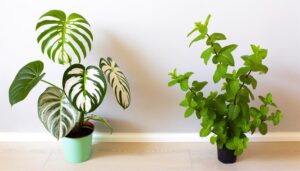Why Are the Edges of My Monstera Leaves Yellowing? Explained
The yellowing edges of your Monstera leaves indicate problems in water management, light exposure, or nutrient levels. Overwatering leads to root rot, impairing nutrient uptake, while underwatering stresses the plant, causing dehydration.
Guarantee your Monstera receives bright, indirect light, avoiding chlorosis from inadequate light. Remember, both low humidity and temperature fluctuations can exacerbate leaf yellowing.
Monitor soil moisture with a hygrometer and use a well-draining mix, maintaining a stable environment between 65-75°F (18-24°C). Regularly check for pests and make certain your pot has proper drainage to prevent nutrient deficiencies.
Investigate these factors to restore your Monstera’s vibrant health.
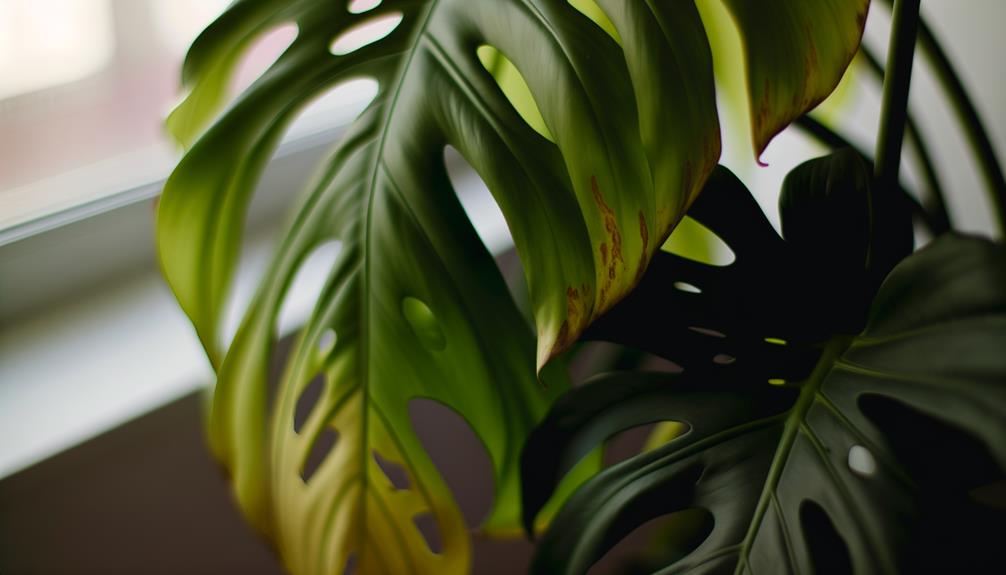
Key Takeaways
- Inadequate watering or inconsistent schedules can cause yellowing leaf edges.
- Low humidity levels accelerate water loss, leading to yellowing.
- Nutrient deficiencies, particularly nitrogen, potassium, or magnesium, can result in leaf edge discoloration.
- Poor soil drainage or overwatering can lead to root health issues, causing yellow edges.
- Exposure to cold drafts or extreme temperature changes can damage leaves, leading to yellowing edges.
Watering Frequency
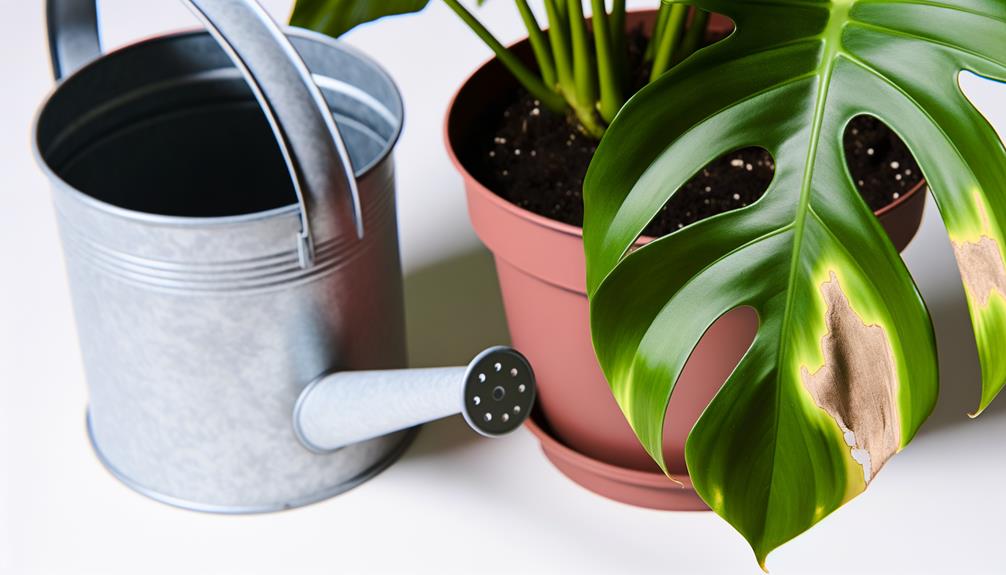
To determine the most suitable watering frequency for Monstera plants, you must consider factors like soil moisture retention, ambient humidity, and the plant’s transpiration rate.
Soil moisture retention is influenced by the soil composition; a well-draining mix prevents waterlogging.
Ambient humidity directly affects transpiration, the process where water evaporates from the plant’s leaves. High humidity levels reduce the plant’s need for frequent watering, while low humidity accelerates water loss.
You should also assess the plant’s transpiration rate, which varies based on light exposure and temperature. Bright, warm conditions increase transpiration, necessitating more frequent watering.
Overwatering Issues
Overwatering is a common issue that can lead to yellowing Monstera leaves by causing root rot and disrupting oxygen uptake. When soil remains overly saturated, anaerobic conditions prevail, fostering pathogenic fungi like Phytophthora. These pathogens attack root systems, leading to necrosis and impaired nutrient transport.
Excess moisture also reduces oxygen availability for root respiration, causing hypoxia. This oxygen deficiency inhibits cellular respiration, resulting in chlorosis and leaf yellowing. Monitor soil moisture using a hygrometer, ensuring it dries slightly between waterings.
Implement a well-draining potting mix, incorporating perlite or orchid bark to enhance aeration. Elevate the pot to improve drainage and avoid waterlogged conditions. Proper water management is essential for maintaining Monstera’s vibrant foliage and overall plant health.
Underwatering Effects
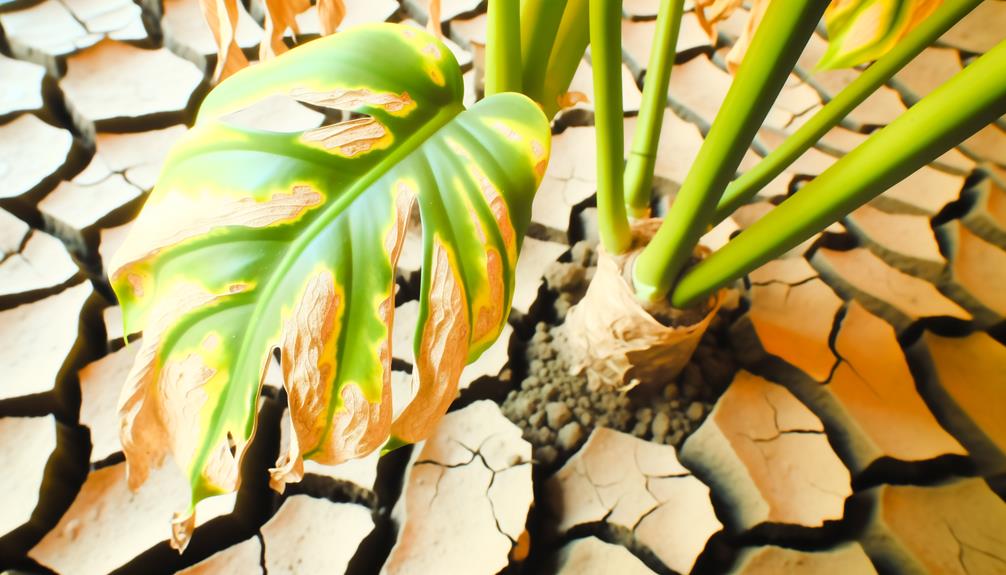
You’ll notice that insufficient soil moisture levels directly impair the plant’s ability to maintain adequate leaf hydration. This leads to cellular dehydration, causing the leaves to yellow as a stress response.
Monitoring soil moisture and ensuring proper irrigation is essential to meet the Monstera’s hydration needs.
Soil Moisture Levels
When soil moisture levels drop too low, Monstera leaves can start yellowing due to insufficient water uptake, leading to cellular dehydration and impaired photosynthesis. This occurs because the plant’s root system can’t absorb enough water to sustain turgor pressure, causing cells to collapse and die.
Inadequate water also hampers the transport of essential nutrients like potassium and magnesium, crucial for chlorophyll production and overall leaf health. Consequently, chlorosis manifests, particularly at the leaf edges.
Additionally, drought stress induces stomatal closure to conserve water, limiting CO2 intake and reducing photosynthetic efficiency. Monitor soil moisture using a hygrometer to maintain ideal hydration levels, ensuring consistent moisture without waterlogging, which can also harm the plant.
Leaf Hydration Needs
Insufficient leaf hydration due to underwatering triggers a cascade of physiological stress responses, manifesting as yellowing and wilting of Monstera leaves.
When water availability is limited, the plant activates its drought stress mechanisms, including stomatal closure to reduce transpiration. This reduction in gas exchange impedes photosynthesis, leading to chlorosis and diminished chlorophyll production.
In turn, the leaf’s cellular turgor pressure drops, causing wilting. Prolonged dehydration affects nutrient uptake, as water is a solvent for essential minerals. Consequently, nutrient deficiencies further exacerbate the yellowing.
To prevent these symptoms, you should maintain consistent watering schedules, ensuring soil moisture levels remain adequate. Employ a moisture meter if necessary, and adjust watering frequency based on environmental conditions and plant needs.
Humidity Levels
Adequate humidity levels are essential for maintaining the health of Monstera leaves, as insufficient moisture in the air can lead to yellowing and other stress symptoms. Monstera plants thrive in environments with humidity levels between 60-80%.
Low humidity causes stomatal closure, reducing transpiration and nutrient uptake, thereby manifesting as yellow leaf edges.
| Humidity Level | Effect on Monstera Leaves |
|---|---|
| 60-80% | Best health, robust growth |
| 50-59% | Minor yellowing, slight stress |
| 40-49% | Noticeable yellowing, wilting |
| 30-39% | Severe yellowing, leaf drop |
| Below 30% | Critical stress, potential death |
To mitigate low humidity, employ humidifiers, mist regularly, or use pebble trays. Monitoring and maintaining correct humidity prevents physiological complications and ensures vibrant, healthy foliage.
Light Conditions
Bright, indirect light is indispensable for Monstera plants to photosynthesize effectively and maintain vibrant, green foliage. When your Monstera doesn’t receive sufficient light, it can lead to chlorosis, where the leaf margins turn yellow due to inadequate chlorophyll production.
Conversely, excessive direct sunlight can cause photodamage, resulting in scorched, yellowing edges.
Consider the following adjustments:
- Relocate your plant to a spot with filtered light to prevent photoinhibition.
- Utilize sheer curtains to diffuse harsh sunlight and reduce light intensity.
- Rotate the plant periodically to guarantee even light distribution and prevent asymmetric growth.
Nutrient Deficiencies
A lack of necessary nutrients, such as nitrogen, potassium, or magnesium, can manifest in Monstera leaves turning yellow due to impaired physiological functions. Nitrogen deficiency often results in chlorosis, where the leaf loses its green pigment, starting from the edges.
Potassium is vital for stomatal function and water regulation; its absence can cause marginal leaf browning followed by yellowing. Magnesium, a central atom in chlorophyll, is important for photosynthesis. Deficiency symptoms include interveinal chlorosis, where the veins remain green while the tissue between turns yellow.
Soil Quality
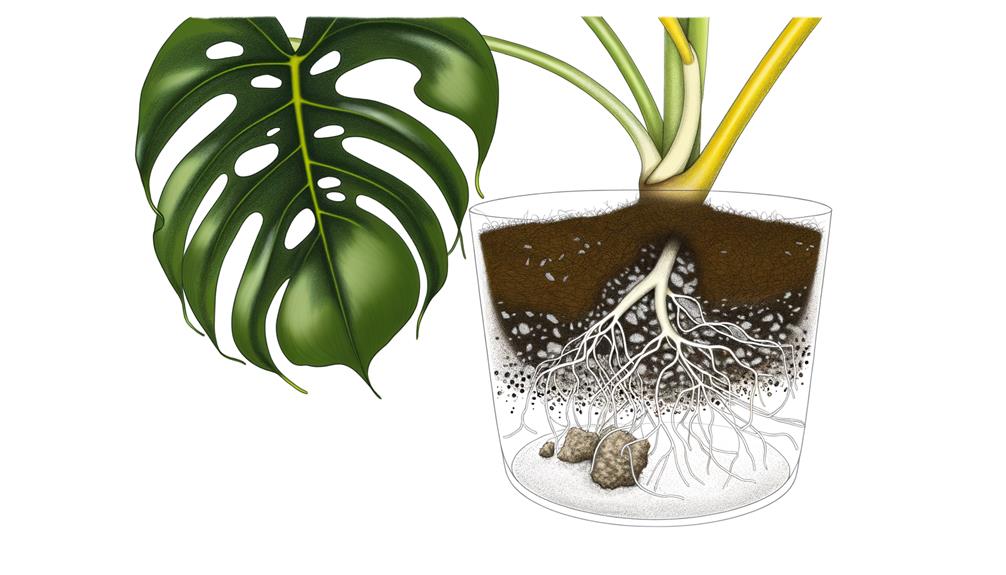
Improper soil quality can significantly impact the health of your Monstera, leading to yellowing leaves due to poor drainage, insufficient aeration, or subpar pH levels. Monstera plants require well-draining soil to prevent root rot, which can cause yellowing.
Inadequate aeration restricts oxygen flow to the roots, impeding nutrient uptake. Additionally, soil pH should be slightly acidic to neutral (5.5 to 7.0) for best nutrient absorption.
To optimize your Monstera’s growth, consider the following:
- Utilize a soil mix containing peat moss, perlite, and orchid bark for balanced drainage and aeration.
- Regularly monitor soil pH using a pH meter or test kit.
- Enhance the soil with organic matter to improve structure and nutrient content.
Pest Infestations
Beyond soil quality, yellowing Monstera leaves can also signal pest infestations, where insects such as spider mites, scale, and mealybugs damage the plant by sucking sap, leading to nutrient deficiencies and chlorosis.
These pests extract essential fluids from the plant’s phloem, disrupting the flow of necessary nutrients. Chlorophyll production diminishes, causing leaf discoloration.
Check the undersides of leaves; pests often hide there, making detection challenging. Employ integrated pest management (IPM) strategies: isolate the affected plant, use horticultural oils or insecticidal soaps, and introduce natural predators like ladybugs. Consistent monitoring and early intervention are fundamental.
Ignoring this issue can exacerbate the problem, leading to stunted growth and further leaf damage. Always maintain regular inspection routines to keep your Monstera healthy.
Temperature Fluctuations
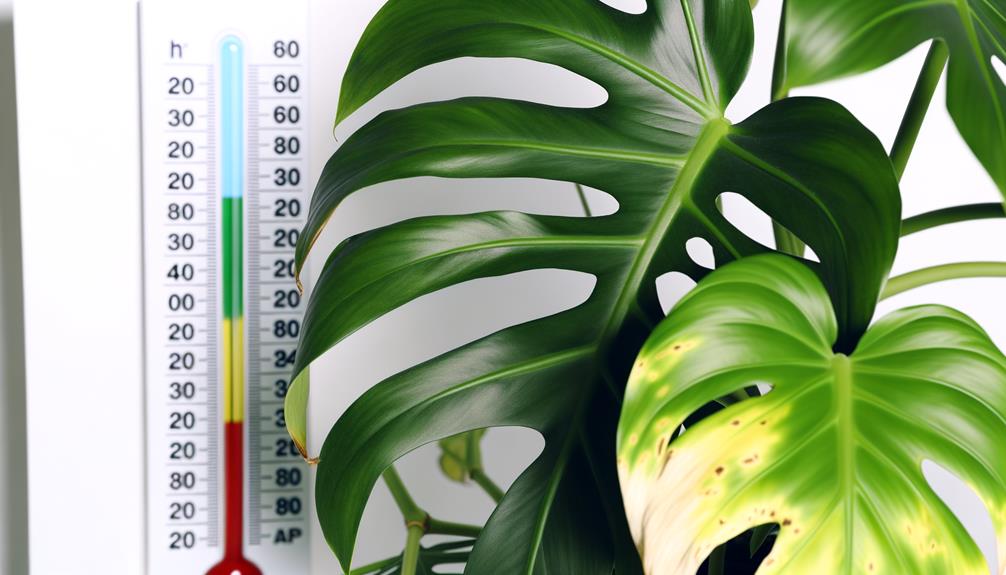
Temperature fluctuations can disrupt the metabolic processes of Monstera plants, leading to stress-induced yellowing of the leaves. When exposed to rapid changes in temperature, your Monstera’s cellular functions become compromised. This results in chlorosis, a condition where chlorophyll production is hampered, causing the leaves to lose their green pigment.
To address these issues, ensure:
- Consistent Temperature: Maintain a stable environment, ideally between 65-75°F (18-24°C).
- Avoid Drafts: Keep your plant away from windows and doors where cold drafts or hot air flows can occur.
- Monitor Heating/Cooling Systems: Sudden shifts from heating systems or air conditioners can lead to stress.
Root Health
You should inspect the root zone for signs of overwatering and root rot, which can hinder nutrient uptake and cause yellowing leaves.
Verify the soil has proper drainage to prevent waterlogged conditions, as inadequate soil drainage can worsen root health issues.
Additionally, assess if the Monstera is root-bound, as tightly packed roots can stress the plant and lead to chlorosis.
Overwatering and Root Rot
Overwatering is a primary cause of root rot in Monstera plants, leading to anaerobic conditions that promote pathogenic fungal growth. When you water your Monstera excessively, the soil becomes saturated, depriving the roots of oxygen.
This leads to a hypoxic environment, encouraging the proliferation of fungi such as Pythium, Phytophthora, and Rhizoctonia. These pathogens decay the root system, impairing nutrient and water uptake, which shows as yellowing leaf edges.
To prevent overwatering, consider:
- Measuring soil moisture: Use a moisture meter to avoid unnecessary watering.
- Watering schedule: Allow the top 2 inches of soil to dry out before re-watering.
- Pot drainage: Make sure pots have adequate drainage holes to prevent waterlogging.
Poor Soil Drainage
Improper soil drainage exacerbates root health issues by creating persistently soggy conditions that suffocate Monstera roots and foster fungal infections.
Waterlogged soil restricts oxygen availability, leading to hypoxic stress and root anoxia. This anaerobic state promotes pathogenic fungi like Phytophthora and Pythium, which cause root rot.
Compromised roots can’t uptake essential nutrients, resulting in chlorosis and yellowing leaf margins. Employ well-aerated soil mixes with components like perlite and orchid bark to enhance drainage. Confirm pots have adequate drainage holes to prevent water accumulation. Regularly monitor soil moisture with a hygrometer to avoid oversaturation.
Root Bound Issues
Root-bound conditions severely restrict Monstera’s ability to access water and nutrients, leading to stunted growth and yellowing leaves. When a Monstera becomes root-bound, its roots coil tightly around the pot, limiting their effectiveness in nutrient uptake and water absorption. This can cause hydrostatic pressure imbalance and nutrient deficiencies.
To identify root-bound issues, you should:
- Check for roots emerging from drainage holes: This indicates the roots have outgrown the pot.
- Observe soil compaction: Highly compacted soil reduces aeration and water movement.
- Examine root health: Look for root circling or tangling when repotting.
Repotting into a larger container with fresh soil improves root health, enhancing nutrient and water accessibility.
Pot Size and Drainage
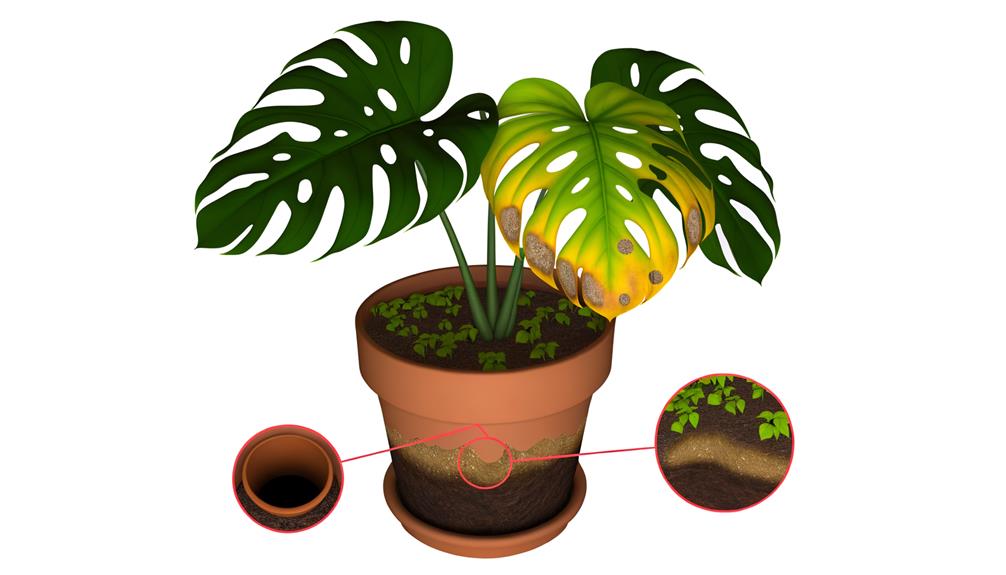
Ensuring your Monstera has an appropriately sized pot with sufficient drainage is essential for preventing yellowing leaves and promoting healthy root development. When the pot is too small, roots become constricted, leading to nutrient deficiencies and oxygen deprivation.
Conversely, oversized pots can cause water to stagnate, promoting root rot. Utilize containers with drainage holes, and consider a well-aerated soil mix to facilitate proper water flow.
| Pot Size | Root Health Impact | Leaf Yellowing Risk |
|---|---|---|
| Too Small | Root Bound, Anoxia | High |
| Just Right | Best Root Growth | Low |
| Too Large | Water Stagnation, Root Rot | Moderate |
Choosing the appropriate pot size and ensuring effective drainage are crucial in maintaining your Monstera’s health.
Conclusion
Think of your Monstera as a delicate machine. Just like an engine needs the appropriate fuel and conditions to run smoothly, your plant requires balanced watering, ideal light, and stable temperatures. Too much or too little of any element can disrupt its harmony, manifesting as yellowing leaf edges.
By fine-tuning each factor—water, humidity, light, pests, and potting—you’ll optimize your Monstera’s engine purrs, showcasing vibrant, green leaves instead of stressed, yellow ones.


